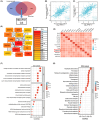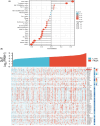Cuproptosis-related gene DLAT is a biomarker of the prognosis and immune microenvironment of gastric cancer and affects the invasion and migration of cells
- PMID: 39031012
- PMCID: PMC11258438
- DOI: 10.1002/cam4.70012
Cuproptosis-related gene DLAT is a biomarker of the prognosis and immune microenvironment of gastric cancer and affects the invasion and migration of cells
Abstract
Objective: Cuproptosis is a novel cell death dependent on mitochondrial respiration and regulated by copper. This study aimed to investigate the cuproptosis-related gene DLAT potential value in gastric cancer (GC).
Methods: Bioinformatics was used to analyze DLAT expression. DLAT expression in GC cell lines was detected using qRT-PCR. Cell proliferation ability was assessed using CCK8 and cell cycle assay. Cell migration and invasion were assessed using wound healing and transwell assay. A prognostic assessment was performed through survival and Cox regression analysis. DLAT protein expression was analyzed through HPA immunohistochemistry. Biological functions and processes were analyzed through GO and KEGG enrichment analysis and PPI. Correlation with immune cell infiltration and immune checkpoint genes was analyzed for DLAT.
Results: DLAT expression was upregulated in GC tissues and cells and correlated with shorter survival for patients. Age, gender, histological typing, lymph node metastasis, and distant metastasis were identified as independent prognostic factors affecting OS in GC. DLAT protein was upregulated in GC. The biological functions and pathways enriched in DLAT were mainly linked to mitochondrial respiration and the TCA cycle. The expression of DLAT was found to be positively correlated with the infiltration of Th and Th2 immune cells and only positively correlated with the expression of the BTN2A1 immune checkpoint gene.
Conclusion: DLAT has the potential to serve as a prognostic assessment factor in GC. The expression of DLAT was correlated with immune infiltration and tumor immune escape, providing a new target for immunotherapy of GC.
Keywords: DLAT; cuproptosis; gastric cancer; immune infiltration; prognosis.
© 2024 The Author(s). Cancer Medicine published by John Wiley & Sons Ltd.
Figures






References
-
- Sung H, Ferlay J, Siegel RL, et al. Global cancer statistics 2020: GLOBOCAN estimates of incidence and mortality worldwide for 36 cancers in 185 countries. CA Cancer J Clin. 2021;71(3):209‐249. - PubMed
-
- Smyth EC, Nilsson M, Grabsch HI, van Grieken NC, Lordick F. Gastric cancer. Lancet. 2020;396(10251):635‐648. - PubMed
MeSH terms
Substances
Grants and funding
LinkOut - more resources
Full Text Sources
Medical
Miscellaneous

